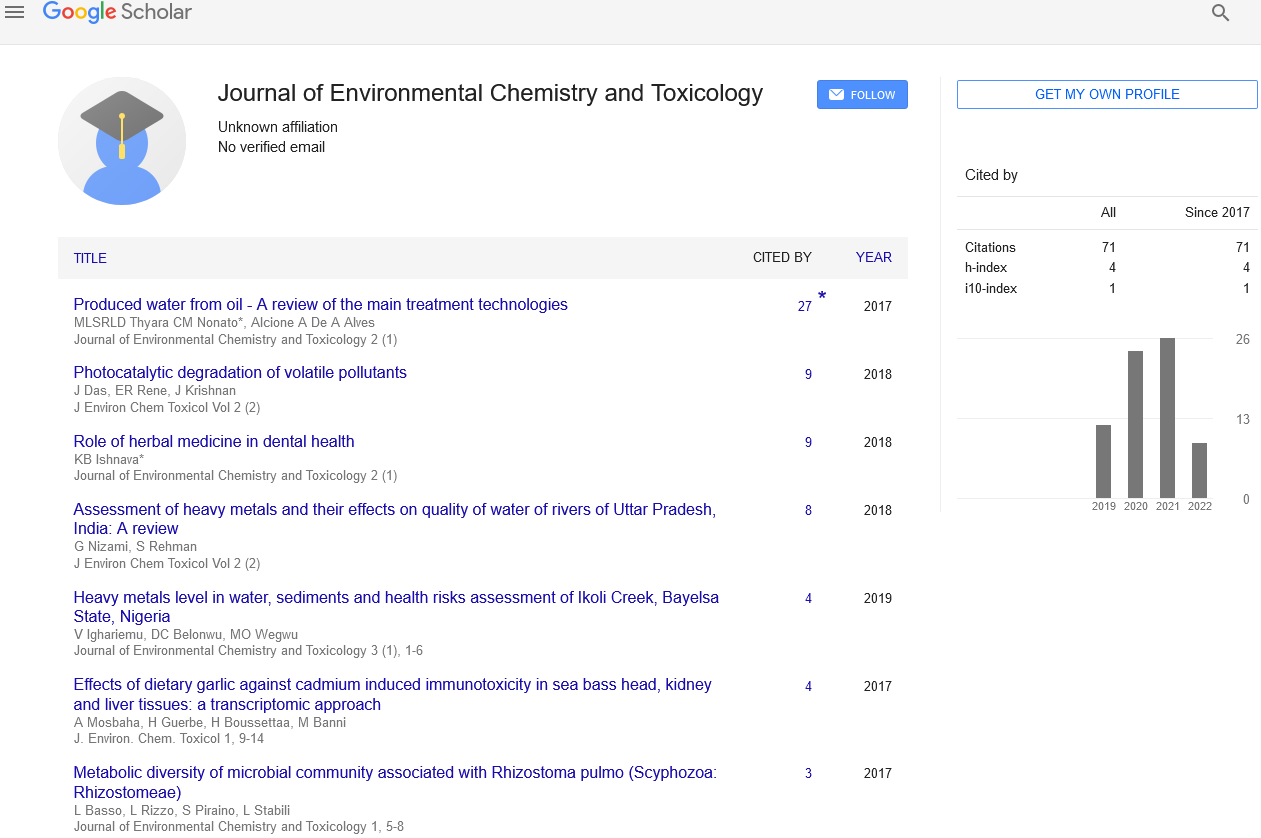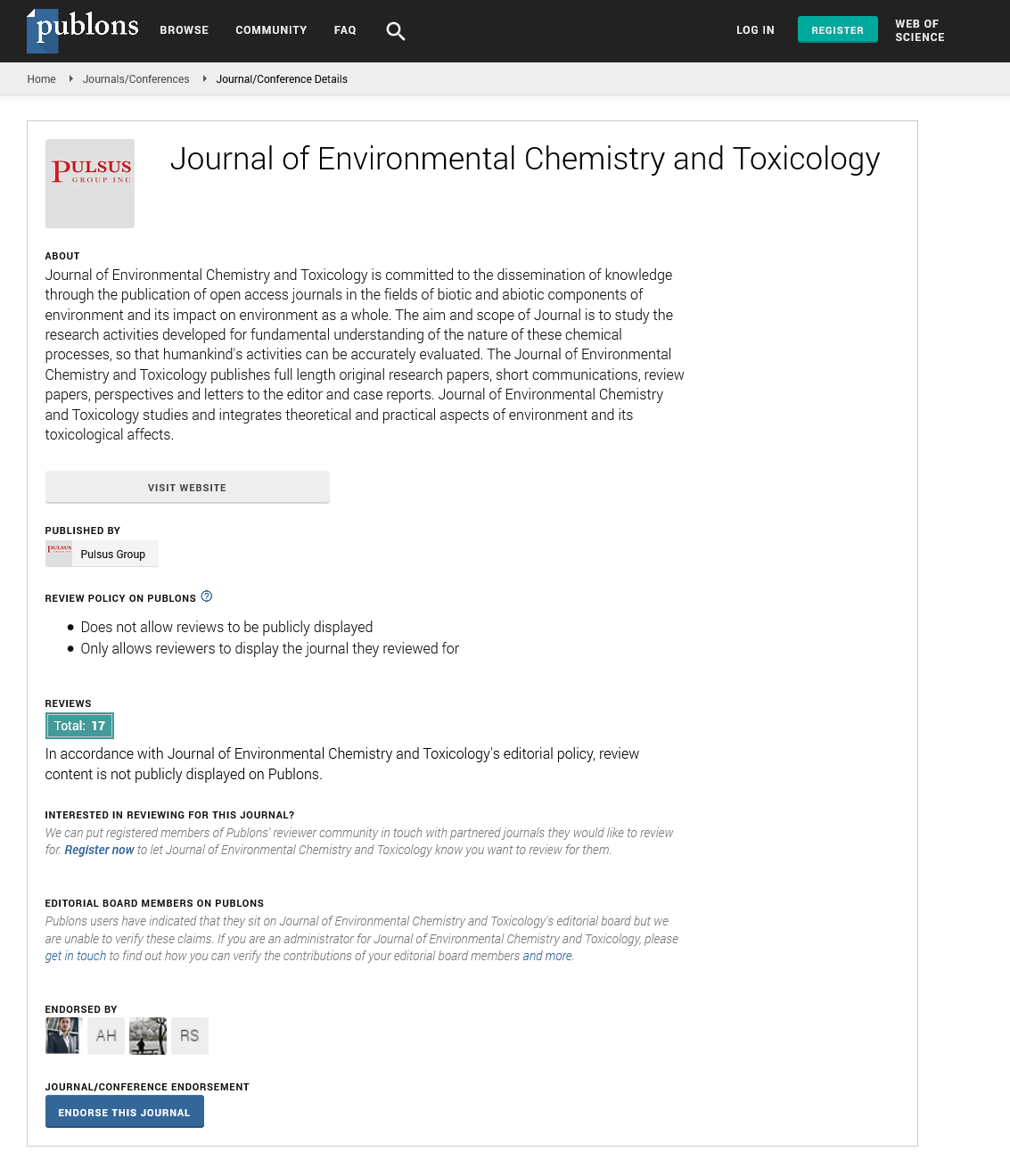Variations of Polychlorinated Biphenyls
Received: 14-Jul-2021 Accepted Date: Jul 23, 2021; Published: 28-Jul-2021
Citation: Steve B. Variations of Polychlorinated Biphenyls. J Environ Chem Toxicol 2021;5(4):1-1
This open-access article is distributed under the terms of the Creative Commons Attribution Non-Commercial License (CC BY-NC) (http://creativecommons.org/licenses/by-nc/4.0/), which permits reuse, distribution and reproduction of the article, provided that the original work is properly cited and the reuse is restricted to noncommercial purposes. For commercial reuse, contact reprints@pulsus.com
Short Communication
Polychlorinated biphenyls are man-made organo-chlorine compounds generated from a biphenyl molecule with up to 209 chlorinated biphenyl isomers. Each of the distinct congener combinations has a specific amount and pattern of chlorine substitution. Less-chlorinated PCBs are colourless, tasteless, clear to pale-yellow viscous liquids, whereas highly chlorinated combinations are viscous, deep yellow, and soft waxy solids. PCBs were first commercially produced in 1929, but their usage has been prohibited or severely restricted in many countries since the 1970s and 1980s due to potential health hazards and environmental persistence. PCBs have been widely employed as insulating materials in electrical equipment such as transformers and switches because to their resistance to acids, bases, and in heat transfer fluids and in lubricants. Plasticizers, surface coatings, inks, adhesives, flame retardants, paints, and carbonless duplicating paper are among the products that use it. Concerns about PCB toxicity in the environment led to restrictions by the US Congress in 1979 and the Stockholm Convention on POPs in 2001. PCBs were previously classified as probable or definite human carcinogens by the International Research Agency on Cancer (IRAC). The International Agency for Research on Cancer (IARC) categorised dioxin-like PCBs as human carcinogens in 2013. Indeed, several studies have linked PCB workers to an increased risk of malignant melanoma and rare liver cancer. Meanwhile, the Environmental Protection Agency of the United States has determined that PCBs cause cancer in lower animals and are likely human carcinogens.
Despite the fact that it is illegal to manufacture PCBs in the United States and many other countries, the PCB regulatory body has approved them for use in electrical equipment, primarily as dielectric fluids. PCBs can still be released into the environment today due to poorly maintained hazardous waste sites containing PCBs, illegal or improper dumping of PCB wastes, leaks or releases from PCB-containing electrical transformers, disposal of PCB-containing consumer products into municipal or other landfills not designed to handle hazardous waste, and the burning of some wastes in municipal and industrial incinerators. Despite the fact that the production and sale of PCBs has been prohibited since 1977, the majority of PCBs are still used in dielectric fluid in electrical equipment servicing industries with high electrical power distribution and consumption, posing potential environmental risks in the event of releases. Transformer oils, capacitors, and other electrical equipment are currently the principal contributors of PCBs in the environment. Ancient fluorescent lighting fixtures, electrical equipment or appliances with PCB capacitors built before PCBs were banned, old microscope oil, and old hydraulic fluid are all examples of consumer products that may include PCBs. The chemical stability of PCBs, such as reduced flammability and favourable physical qualities, such as electrical insulating capabilities, contributed to their broad commercial utilisation.
Environmental stability, biological persistence, and lipophilicity are three critical features of PCBs that help them accumulate in the food chain. PCBs have found their way into the environment as a result of their use and disposal, their environmental fate is both complex and worldwide in scope. In the natural environment, PCBs are known to resist oxidation and reduction, making them very stable molecules that do not degrade or decompose easily. They are insoluble in water and have a long half-life of roughly 8 to 15 years, which contributes to their stability. Furthermore, PCB elimination via chemical, thermal, and biological processes is difficult and time-consuming Complete oxidation of di-benzodioxins and di-benzofurans produces exceedingly poisonous di-benzodioxins and di-benzofurans, which is highly problematic. PCBs are mostly found in food, but they can also be found in the workplace. Chloroacne, skin colouring, liver failure, reproductive abnormalities, dermatitis, disorientation, developmental toxicity, and oncogenicity have all been described in persons exposed to PCBs. According to studies, some PCBs have the ability to affect mammalian reproductive systems. PCBs are a substantial threat to persons and the environment, according to a variety of research findings, even at very low doses.






